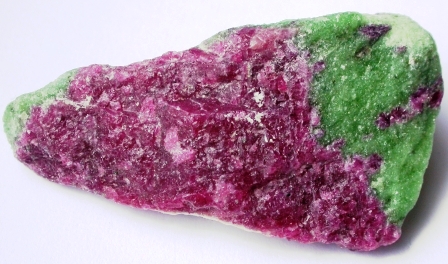
| Crystal system | Orthorhombic |
| Transparency | Transparent to opaque |
| Luster | Vitreous (pearly on clevage surface) |
| Fracture | Uneven to Sub-Conchoidal |
| Cleavage | Perfect pinacoidal |
| Specific Gravity | 4.00 |
| Hardness | 6 to 7 |
| Optical Character | Biaxial+ Double Refractive |
| Refractive index | 1.691 - 1.704 |
| Birefringence | |
| Dispersion | 0.006 |
| Fluorescence | none |
| Pleochroism | Strong; blue, violet and yellow green |
| Chemical Formula | Ca2Al3Si3O13 |
| Comments | |
| Streak | |
Zoisite (ZO-iss-site) is a transparent to opaque mineral species; a member of the epidote group.
Its principal varieties are a transparent, highly trichroic blue; a massive, semitransparent to semi-translucent light red to purplish red, often mottled with gray or; white (thulite); and massive white to grayish green to yellowish green (saussurite). Highly attractive and desirable faceted stones are fashioned from the transparent blue material, which is sold under the trade name Tanzanite. Thulite is used for cabochons and sometimes for cameos and intaglios. Saussurite finds occasional use as a jade substitute. Saussurite is an alteration product of massive feldspar and may contain areas of unaltered feldspar. The feldspar usually fluoresces red under shortwave ultraviolet.
Chemical composition, calcium-aluminum silicate (Ca2Al3Si3O13); crystal system, orthorhombic; hardness, 6 to 6 1/2 (transparent blue, 6 1/2 to 7); specific gravity, 3.25 to 3.27 (transparent blue, 3.35 to 3.55); refractive index, 1.700 - 1.706 (transparent blue, 1.691 - 1.704); birefringence, .006 (transparent blue, .013).
Sources: Tanzania (transparent blue material discovered in 1967); Sau-Alp,
Carinthia; Salzburg, Austria; Zillerthal, Austrian Tyrol; Trentino,
Italy; Zermat, Switzerland; Gefrees, Bavaria; Ross-shire, Scotland.

